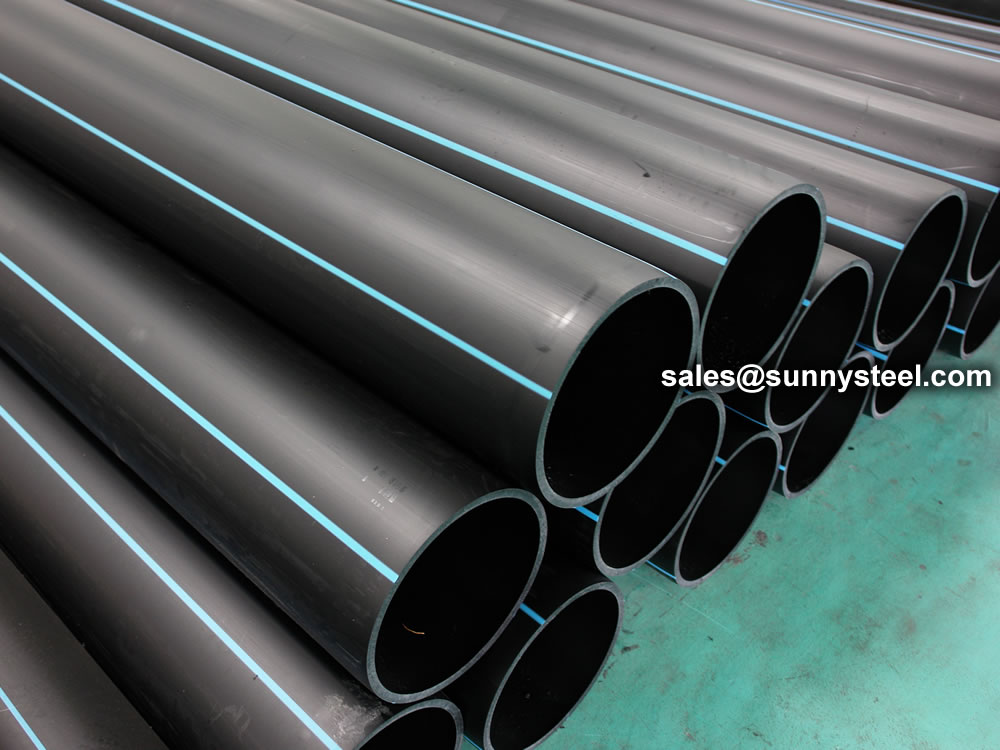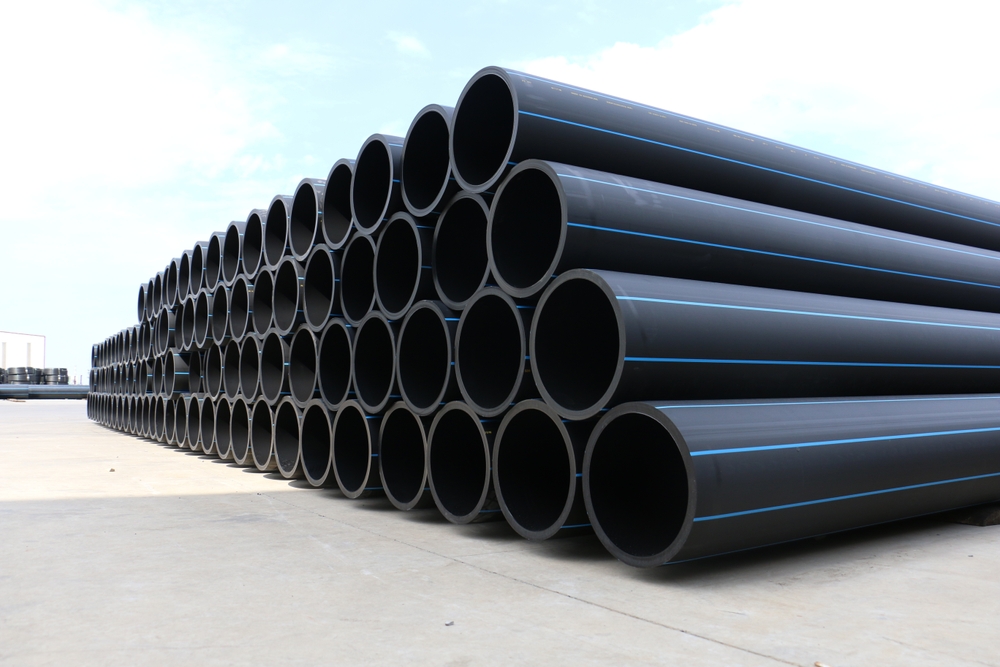American Plastics HDPE Pipe for Oilfield: Preferred in the Oilfield
Wiki Article
Check Out the Manufacturing Process Behind High-Quality HDPE Pipe and Its Applications
The production process of high-quality HDPE pipelines is elaborate and systematic. It starts with the choice of resources that enhance efficiency. Following this, ethylene undergoes polymerization to form material, which is after that shaped through extrusion. Quality assurance is extremely important, guaranteeing that the last item fulfills strict standards. The journey of HDPE pipes doesn't finish with production. Their applications throughout various industries disclose a more comprehensive importance worth analyzing.Comprehending HDPE: Qualities and Advantages

High-density polyethylene (HDPE) is a versatile polycarbonate understood for its toughness and resistance to various ecological elements. This material shows superb tensile stamina, making it suitable for requiring applications. Its low-density structure adds to a light-weight product, promoting simplicity of dealing with and installment. HDPE likewise showcases remarkable resistance to chemicals, which lessens deterioration when subjected to harsh materials.
The product's reduced moisture absorption further boosts its durability, making it optimal for usage in pipelines and tank. In addition, HDPE is immune to ultraviolet (UV) radiation, ensuring that products keep their stability even when exposed to sunlight. Furthermore, its versatility allows for the creation of complex shapes without compromising strength. The environmentally friendly nature of HDPE, often originated from recycled products, contributes to its appeal, promoting sustainable practices in production. Overall, these residential properties and benefits make HDPE a favored choice for various commercial and customer applications.
Resources Option for HDPE Manufacturing
The choice of raw materials for HDPE production is important to verify the end product meets the desired requirements and top quality requirements. High-density polyethylene (HDPE) is primarily created from polymerized ethylene, originated from fossil gas such as all-natural gas or petroleum. The top quality of these feedstocks significantly influences the mechanical and thermal residential or commercial properties of the last HDPE.Additives also play a substantial role in improving HDPE's performance, including antioxidants, UV stabilizers, and colorants, which improve durability and resistance to ecological aspects. The choice procedure must consider not just the chemical make-up of the raw products however likewise their handling qualities to guarantee reliable production.
The sourcing of raw products need to focus on sustainability and conformity with environmental policies, as accountable techniques are necessary in today's market. Eventually, mindful raw material selection lays the foundation for producing top notch HDPE pipes suitable for varied applications.
The Extrusion Refine: Forming HDPE Pipe
The extrusion procedure plays a vital function in forming HDPE pipelines, beginning with precise product prep work techniques that assure excellent flow and consistency. Just as crucial is the style of the die, which straight influences the final measurements and surface area high quality of the pipeline. With each other, these aspects add greatly to the performance and top quality of HDPE pipeline production.Material Prep Work Techniques
Effective production of HDPE pipes starts with careful material prep work techniques, particularly the extrusion process. Throughout this phase, high-density polyethylene resin is first dried out to get rid of moisture, ensuring ideal flow qualities. The resin is after that fed into the extruder, where it undertakes home heating and melting, changing into a viscous state. This heating procedure is carefully managed to keep the product's honesty and performance. The molten HDPE is forced with a die, forming it right into a continuous pipeline kind. Proper temperature level monitoring throughout extrusion is vital, as it straight impacts the material's homes and the last item top quality. When formed, the HDPE pipe is cooled down and reduced to specified lengths, ready for succeeding handling and applications.Die Design Relevance
Accuracy in die design plays an essential function in the extrusion process of HDPE pipelines. The die functions as the last shaping tool, directly affecting the pipe's dimensions, wall surface density, and surface area finish. A properly designed die assurances uniform product flow, decreasing flaws such as abnormalities and weak spots. The geometry of the die have to be maximized to fit the details homes of HDPE, including its thickness and thermal behavior throughout extrusion. Furthermore, the cooling price of the material as it travels through the die can considerably impact the pipeline's architectural integrity. As a result, buying sophisticated die innovation is vital for producers aiming to create high-grade HDPE pipes that fulfill market requirements and customer assumptions.High Quality Control Measures in HDPE Production
Although numerous aspects influence the quality of HDPE pipeline manufacturing, effective quality control steps are crucial to guarantee uniformity and integrity in the final product. Secret top quality control techniques consist of extensive material inspection, confirming that the raw polyethylene meets established criteria for pureness and density. Throughout the extrusion process, specifications such as temperature level, stress, and cooling time are closely kept an eye on to keep dimensional accuracy and architectural honestyIn addition, post-production testing is important; producers commonly perform hydrostatic tests to assess the pipe's toughness and resistance to stress. Visual examinations for surface problems further enhance quality control. Certification from pertinent criteria organizations, like ASTM or ISO, provides an extra layer of reliability. By executing these extensive top quality control steps, suppliers can minimize problems, boost performance, and make sure that the HDPE pipelines fulfill the details demands of different applications, eventually bring about client contentment and trust in the product.
Applications of HDPE Pipeline Throughout Industries
HDPE pipelines are utilized throughout various industries as a result of their durability and adaptability. In water distribution systems, they assure reliable shipment, while in wastewater administration, they offer reliable remedies for waste transportation. Furthermore, farming irrigation networks benefit from HDPE's resistance to rust and flexibility, making it a perfect selection for modern farming techniques.
Water Circulation Solutions
A substantial variety of sectors count on high-density polyethylene (HDPE) pipelines for efficient water distribution systems. Recognized for their resilience and resistance to rust, HDPE pipes are commonly made use of in community water supply networks, agricultural irrigation, and industrial applications. Their lightweight nature assists in easy handling and installation, minimizing labor prices and time. Furthermore, HDPE pipelines can accommodate different pressure levels, making them ideal for both reduced and high-pressure systems. custom hdpe pipe manufacturing Midland TX. The versatility of the product enables smooth integration into existing framework, decreasing the demand for substantial excavation. In addition, HDPE's resistance to chemical seeping guarantees that the water delivered remains risk-free and clean, making it an ideal selection for maintaining the high quality of safe and clean water across numerous marketsWastewater Monitoring Solutions
Efficient water distribution systems additionally lead the way for innovative wastewater management services, where high-density polyethylene (HDPE) pipes play a substantial duty. Popular for their durability and resistance to rust, HDPE pipes are perfect for transporting wastewater in various setups. Their adaptability enables easy installment in complicated settings, lessening the need for considerable excavation. Additionally, HDPE's smooth indoor surface area reduces friction, enhancing flow rates and efficiency. These pipelines are likewise resistant to chemical leaching, ensuring that pollutants do not jeopardize the surrounding environment. Industries, municipalities, and treatment facilities progressively depend on HDPE pipelines for their dependability and durability, making them a recommended choice for modern-day wastewater management systems. This versatility emphasizes the important significance of HDPE pipes throughout countless applications.Agricultural Irrigation Networks
Agricultural watering networks benefit significantly from the usage of high-density polyethylene (HDPE) pipes, which supply reliable and trustworthy water distribution to plants. HDPE pipes are lightweight, making them very easy to carry and install, while their versatility enables for numerous setups in diverse terrains. These pipelines demonstrate excellent resistance to deterioration, chemicals, and UV radiation, guaranteeing toughness in severe agricultural atmospheres. Additionally, their smooth indoor surface reduces friction loss, maximizing water flow and reducing energy prices connected with pumping. The long life of HDPE pipelines, usually going beyond half a century, contributes to decrease upkeep and substitute expenses. Farmers progressively rely on HDPE pipes to improve watering effectiveness and advertise sustainable farming methods, ultimately leading to improved plant yields and resource conservation.
Future Fads in HDPE Pipeline Innovation
As the need for sustainable and efficient infrastructure expands, improvements in HDPE pipe technology are poised to change different sectors. Arising fads consist of the combination of clever innovations, such as sensing units and IoT capabilities, which assist in real-time surveillance of pipe problems, lowering upkeep expenses and stopping leakages. Additionally, the development of advanced manufacturing techniques, such as 3D printing, is enabling the manufacturing of complex, tailored pipe styles that cater to specific job requirements.The emphasis on recycling and round economic climate practices is driving the development of HDPE pipelines made from recycled materials, boosting sustainability. Boosted jointing methods, such as electro-fusion and mechanical installations, are additionally boosting installation performance and reliability. The growing emphasis on ecological regulations is pushing suppliers to adopt greener production procedures, making sure that HDPE pipes not only meet market requirements yet also promote an even more sustainable future for framework advancement.
Regularly Asked Questions
How Does HDPE Contrast to Other Plastic Products?
HDPE outmatches several various other plastic products concerning toughness, chemical resistance, and versatility. Its reduced density and high tensile toughness make it perfect for different applications, commonly going beyond alternatives in both efficiency and longevity.What Are the Ecological Influences of HDPE Manufacturing?
The environmental effects of HDPE manufacturing include greenhouse gas discharges, power intake, and prospective contamination from making processes. In addition, improper disposal can bring about dirt and water contamination, raising worries concerning long-term eco-friendly results.Can HDPE Pipes Be Reused?
Yes, HDPE pipelines can be reused. Many facilities approve used HDPE for handling, changing it right into new products. This reusing adds to sustainability efforts, minimizing plastic waste while conserving sources and energy in the manufacturing cycle.What Is the Lifespan of HDPE Pipes?

Exactly How Do Temperature Variants Influence HDPE Pipe Efficiency?
Temperature variants considerably influence HDPE pipe performance, impacting flexibility and stamina. High temperature levels can cause softening, while reduced temperature levels may cause brittleness, inevitably affecting the pipeline's resilience and viability custom hdpe pipe manufacturing Midland TX for various applications in diverse atmospheres.Report this wiki page